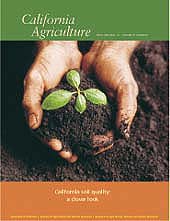All Issues
Letters: October-December 2003
Publication Information
California Agriculture 57(4):101-101.
Published October 01, 2003
PDF | Citation | Permissions
Full text
Antioxidants and pesticides
The science brief “Pesticide-free produce may contain antioxidants” in the April-June 2003 issue deals with a controversial subject. Such claims for differences between organic (or sustainable) production and conventional agriculture have not yet been scientifically demonstrated.
The word “may” in the title is especially appropriate for data derived from “matched plots,” a test procedure that is not normally considered to be statistically valid, and for produce “grown by a farm in Oregon, then frozen, freeze-dried or air-dried before the nutrients were measured” without any indication of who actually planted, grew and harvested, as well as prepared the produce for analysis. Further, there is no indication of the number of samples of each produce type for each plot; nonetheless, the text claims that the percentage values are “nutritionally significant,” but fails to note what the range of values (standard deviations) were for each group or the statistical significance of the percentage values for each group. This speculation about the biochemical justification for the differences is meaningless unless the validity of the claimed effect can be statistically demonstrated.
If the research had been published in a peer-reviewed journal, as was the following piece on the breakdown of pesticides by microorganisms, these comments would not have been made since that would have demonstrated that the information was supported by adequate statistical information not included in the article.
Jack C. Schwegmann, Retired Plant Pathologist Alameda
Editor's note: The science brief in question was based on a peer-reviewed article published in the Journal of Agricultural and Food Chemistry (Feb. 26,2002). Reference to this article was cut due to space constraints; California Agriculture regrets any confusion that resulted. California Agriculture's research articles (labeled above the title) present peer-reviewed data. Science briefs are simply news summaries, reviewed by sources for accuracy.
UC Davis scientist Alyson Mitchell responds: This research has generated a running debate in the pages of the scientific press. Although limited in its design, our study and others like it demonstrate a trend of higher phenolics in organic produce. We hope this debate leads to increased research evaluating relationships between cultural practices and phenolic levels in crops. My colleagues and I have prepared a further response, to be published in a future Journal of Agricultural and Food Chemistry. Readers can also obtain an overview of this subject by reading the July 16, 2003, New York Times article, “Is Organic Food Provably Better?" by Marian Burros.
Genetically modified foods
The article by N. King (“Low income consumers, though less aware of genetically modified foods, are concerned and want labels,” July-September 2003) was good, fairly done and interesting. Usually your authors report about what they have done or can accomplish to please the farmer, but say less on how they are pleasing the consumer. This survey did reveal the latter, and more.
To an ole horticulturalist who has written chapters and given many lectures on pests and pesticides, the engineers made a mistake on the “Bt” insecticidal gene, which is now almost across the board in our food. How in the world this mistake can be corrected is a mystery to me. While the engineers do have a future, they're moving too fast; they need to take a little of their big grants to run and publish feeding tests to prove to EPA and consumers the safety of their products.
California Agriculture is still about the best of its kind around. I wouldn't want to miss reading it.
Norm Childers, Professor
Institute of Food and Agricultural Sciences University of Florida, Gainesville
Cal Ag an “information bulwark”
California Agriculture has proven a bulwark of information for many of my professional and personal decisions over the years. Not the least of these has been irrigation-system details, fruit-tree selection and pruning, turf-grass culture and selection, and beekeeping. The many articles on water resource development have prompted my attendance at Commonwealth Club sessions on water distribution politics and appropriate technology conferences at UC Davis over the years.
John Baird
Napa
With profound sadness, California Agriculture reports the death on Sept. 3 of Associatie Editor Donald Lee Dahlsten, UC Berkeley professor of insect biology and leading expert in biological control and forest entomology. Dahlsten died at age 69 after a 2-year battle against skin cancer. California Agriculture deeply appreciates his service to the magazine. Please send donations to support outreach programs for K-12 students to: donald Dahlsten Outreach Fund, c/o College of Natural Resources, UC Berkeley, 101 Giannini Hall, #3100, Berkeley, CA 94720-3100.






